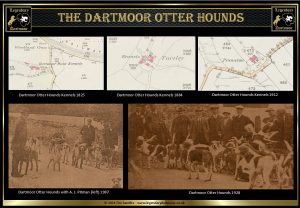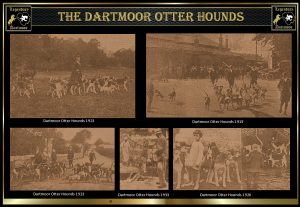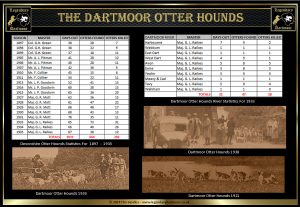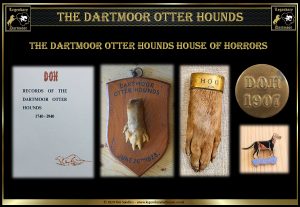
Today the very thought of Otter hunting is abhorrent and barbaric and thankfully came under protection under the ‘Wildlife and Countryside Act in 1981 and later with the Conservation of Habitats and Species Regulations of 2017. This means it is illegal to deliberately kill, injure, disturb or capture them, damage or destroy their breeding sites and resting places – even if otters are not present, or possess, control or transport them – alive or dead. It is also an offence under the Wildlife and Countryside Act 1981 to intentionally or recklessly: disturb otters while they occupy a structure or place used for shelter or protection or obstruct access to a place of shelter or protection. Over the past decade or so some of the Dartmoor rivers are now home to nationally important populations of otters thanks to concerted conservation efforts.
However, otter hunting was one of Dartmoor’s traditions and although it cannot in the slightest be condoned it also should not be ignored as a part of history. It is rather ironic that one form of sport came about purely to protect another form of sport. As with any form of hunting there was always a reason (call it an excuse if you like) for such sport. In the case of the otters the only plausible reason was to protect the valuable fish stocks of the main rivers. Dartmoor has always been an important area for fishing which provided the local economy with a welcomed income. This came in various forms such as hotel accommodation etc. for the anglers, employment for the water bailiffs and local guides, income from fishing licences, and rent for the landowners who owned the riversides.
But what part did the existence of otter hounds play and why on Dartmoor? One reason may be this, “The Dartmoor district is a capital one for the summer sport of otter hunting. From the highlands of the moors the drainage is carried down to the sea by very many rivulets which, as the distance they have to travel in not long, have not the opportunity to become either large or deep. As a consequence, most of the South Devon waterways are practicable for hounds almost down to the sea.” – The Field, July, 1901. Again local businesses reaped a reward from the hound in numerous ways such as trade from the hunts and their followers and visitors. The hounds themselves were a means of employment for the Masters and huntsmen, local vets and the dogs were a convenient way of disposing of dead livestock. It was very common to read in adverts for Dartmoor houses or farms comments such as “Fox Hounds, Harriers, and Otter Hounds meet in the neighbourhood, and there is excellent fly fishing about a mile distant,” as a major selling point. Some would also aver that the ‘sport’ provided an important social factor for those participating or following.
Putting all this to one side, the other inexcusable reason was to provide a day’s sport for locals and visitors which in many cases were well attended. As an indication of how local the sport was is this conversation from 1850. “A local friend called at the village blacksmiths to get his horse shod; but he was told by a boy that “Maester was a-go a hunting.” He then went to the butcher’s shop, then to the carpenter’s shop and at each was told “Maester was a-go a hunting.” Well said my friend, “as they all seemed to have turned out, I may as well do so too;” so going in pursuit he soon came upon a large party. “The butcher, the baker, the candlestick maker,” enjoying their lives on top of a hill, and listening with intense interest to the “crack of music,” with which the valley was ringing.” Otter Hunting was not only the preserve of man, it was reported that in 1832 there was just one lady participating in the hunt but in later years it soon grew in popularity amongst women as can be seen from the photos below.
Initially there was no dedicated pack of otter hounds but dogs which would hunt “such other quarry as came handy,” such as terriers. In 1825 one Squire Pode established what was said to be the oldest pack of otter hounds in the United Kingdom which became known as “The Dartmoor Otter Hounds.” These hounds shared the kennels with the Dartmoor Fox Hounds at Ivybridge Pode’s first huntsman was John Roberts who held the office until 1832. Squire Pode was succeeded by John Crocker Buteel who improved the breeding of the pack by introducing fox hound blood into the dogs. His huntsman was ‘Gypsy Limpetty’ of which it was said, “was as wild as the animal he pursed and one who had seen his piercing eye, or heard his rich scream, could ever forget him.” In 1843 the mastership of the pack came under Charles Trelawny and in 1874 it was handed over to Mr. A Munro. He was the succeed by Admiral George Parker in 1877 who in turn was replaced by Mr. Gage Hodge of Glazebrook in 1884. It was under his mastership that the pack were moved to new kennels at Turtley near South Brent. Major Green took over as Master of the Hunt in 1892 and was followed by Mr. A J. Pitman in 1903. there was then a quick succession of Masters with Mr. F. Collier in 1910 and Mr. J. D. P. Goodwin in 1912 and at this time the kennels were moved to Pennaton on the Glazebrook. In 1926 Mr. Goodwin suddenly died whilst in bed and so Mr. R. W. Baynes became acting Master later to be succeeded by Major R. J. K. Mott in 1930 who then handed over to Major General Raikes in 1933.
Some years ago I managed to buy a self published manuscript written by G. R. Mott (see above) and called “Records of the Dartmoor Otter Hounds 1740 -1940. Inside were numerous accounts of otter hunts throughout Devonshire and further afield such as Cornwall. In the two tables above pertaining to the Dartmoor Otter Hounds you can see the stats of the hunting days, the Masters, otter sightings, and otter kills along with similar stats for the various Dartmoor rivers. It is noticeable how the numbers of hunting days rapidly increase from around the 30 days in the late 1800s to more than double than by the early 1900s. Naturally as the number of days hunting increased to the 60s and 70s the number of otters found also doubled although the number of otters killed remained rather static. The most sickening factor being that between 1897 and 1935 269 otters were hunted and killed in the rivers of Devonshire. This indicated that just over a half of the otters that were found resulted in a kill. In the actual Dartmoor rivers the number of otters killed in 1933 was 18 which equated to roughly half of the Devonshire total for the year. The big question here being does the fish in the Dartmoor rivers and the so-called sport of otter hunting warrant such slaughter? – quite frankly no! It is also worth remembering that the persecution of otters was not only down to hounds, in some cases they were caught in traps or even shot and speared. Additionally, at the height of the mining era on Dartmoor effluent from the mines would often seep into the rivers and pollute them. There are numerous newspaper reports of the time where the moorland fish conservators complained about various mining concerns polluting their rivers and killing the fish. What goes around comes around and today the same threat of pollution comes from farmers, industrial companies and water companies releasing fertilisers, chemical waste and sewage into the rivers. Thankfully this is not a problem on upland Dartmoor but it can have an effect in the lowlands as the various rivers make their way to the sea.
As the popularity of otter hunting waned the Dartmoor Otter Hounds took up another role. Since the early 1900s there were several skunk and mink farms established on and around Dartmoor. Primarily these businesses were set up to supply fur for the fashion industry to make stoles, mufflers etc. The general census of opinion became anti-fur fashion and so many of these fur farms ceased trading. In some cases the mink were simply released into the wild or they had managed to escape on their own accord. Either way they soon found their way into the various rivers and began causing problems for other wildlife and also domestic fowl. In the 1960s it was said that Devonshire had the largest population of mink in the United Kingdom with the Teign and Dart rivers being especially overrun. One of the solutions to this problem was to use otter hounds to hunt them. In 1972 the mink population was causing serious problems in Devonshire and so the possibility of hunting them with the virtually redundant otter hounds. Mr. E. F. Windeatt, the then treasurer of the Dartmoor Otter Hounds, commented that “I think there is indeed scope for catching mink, and I think it is essential they are caught. Mink are not only catching fish, but duck, rabbit and waterfowl. They are pretty fearsome animals. The best way to hunt mink might be a combination of hounds with some terriers. The Dartmoor Otter Hounds have been catching mink for two years.” In 1973 the Dartmoor Otter Hounds were called upon to hunt the Stoneycombe Valley near Newton Abbot. Here the mink population were posing a threat to the local chickens, wildlife and, believe it or not, pet cats. As the American Mink is not a native species it is not protected by law, however under the hunting with dogs act it has been illegal (in theory) to hunt them since 2004. It is believed that there are still mink packs working today in Devon and Cornwall.
Not every hunt ended in the slaughter of otters as described in 1835. “Even in these days there was a certain amount of romance attached to otter hunting, as on the Plym on a day in July when they found above Plym Bridge and had him up two or three hours, but did not kill, as the pretty girls and the picnic spread engaged the hearts of the gallants and the hungry ones.”
Similarly – “A great turmoil of waters on the 15th of July, 1859, affected the hunt on the Erme, and on the 29th of July a terrible fall of water followed by a destructive flood. Cadover was washed away.”
An account of 1904 clearly illustrates the distance and determination some of these hunts consisted of, again without success.“There was a good field out to meet Mr. A. Pitman, the Master at Buckfastleigh on Monday. Arthur Mason, the huntsman, had 11½ couples of hounds and the terrier tip with him. After lingering for a time around the famous old chestnut tree the hounds were taken down river about a quarter of a mile and cast upstream. A portion of the field followed them up past the railway station, whilst others kept the road past the Monastery, through the factory at Buckfast, re-joining them at Berry Meadows. Arthur carefully hunted his pack up to Blackpool, which was well tried, but this favourite pool proved blank. Up stream the hounds made a very solid mark on the right bank close to Hembury Gate. Racket was the most persistent and stuck to it. Tip went up but failed to get at him. Tools were soon at work; the earth was opened up and our otter was shifted from one place to another two or three times. It was a very big, strong holt, running along the bank for several yards, and as hollow as a honeycomb. After about two hours hard digging the Master decided to abandon the stronghold. Tried up through Mr. Dawson’s lovely ground of Holne Park, Holne Bridge was reached where a rest for lunch was very welcome after the hot walk. A pleasant half-hour over, Arthur’s merry horn called the hounds and huntsmen forward. Up past Chase House, through Buckland Drives to Lover’s leap, all safe – and thankful for it, for during lunch both hounds and followers had a narrow escape as the “Moorman” express rounded Holne Bridge corner driving from 12 to 14 miles an hour without as much as blowing his whistle… Arthur continued to work hard, drawing right up past Spitchwick not Newbridge on the Dart without getting a touch. This was more disappointing, as it was certain that we had left an otter behind at Hembury.” – The Western Guardian, June 30th, 1904.
Another good example of a failed hunt was in the July of 1911. “After a sticky hunt in Hood Pool on the Dart, hounds were pulled out and rested. On resuming, the watcher who had been posted at the top of the pool was found reading a newspaper! Once over the top shallow, hound s hit off the line of their otter and never came up with him till they marked him in Weir Pool over two miles upstream. It was then too late to hunt him in this difficult pool.”
So, it’s plain to see why the otter numbers on Dartmoor declined so dramatically. With the thinking of today it is inexcusable that such a magnificent creature was hunted to near extinction on and around the moor. But we cannot change history or pretend it never happened and the best to hope for is that vital lessons have been learnt, sense prevailed and hopefully the otter numbers will continue to increase and reach a healthy and sustainable number. But what mankind preserves on one hand he manages to destroy on the other. Today the biggest threat to otters is that of river pollution of various kinds. Clearly on upland Dartmoor agricultural fertilisers and chemicals are not a big issue but lower down on the lowlands this can be the case.
 Legendary Dartmoor The many aspects past and present of Dartmoor
Legendary Dartmoor The many aspects past and present of Dartmoor




